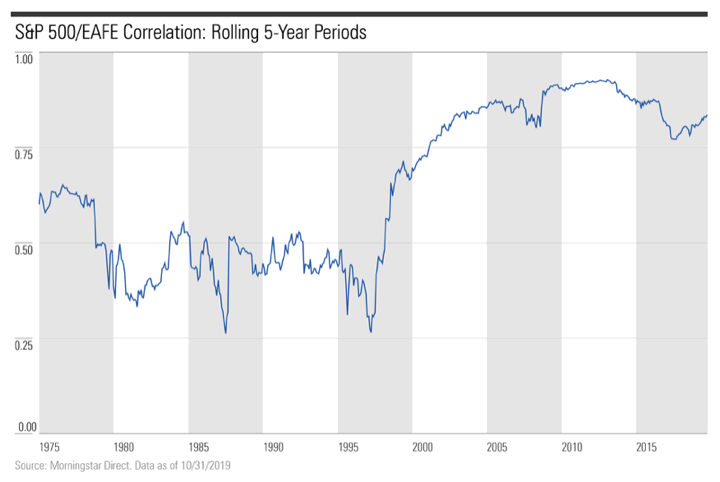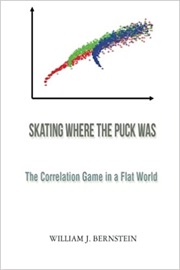If you like having a complicated portfolio and owning exotic asset classes for diversification, you might want to prepare yourself before reading Skating Where the Puck Was: The Correlation Game in a Flat World by William Bernstein. Most of the exotic classes you’ve ever thought about owning will be struck down:
- Commodities futures? – disaster.
- Private equity? – nope.
- Hedge funds? – don’t bother.
- Gold? – sorry, even the Permanent Portfolio would have been better off historically without gold if you measure since 1980 (after going off gold standard).
The basic premise is “Rekenthaler’s Rule”: If the bozos know about it, it doesn’t work any more.
Even international stocks are not nearly as useful a diversifier as they used to be. The book included a chart of the correlation between the S&P 500 (developed large-cap US stocks) and EAFA (developed large-cap international stocks), but I found a more recent one from Morningstar. International stocks used to offer high returns and low correlations, the ideal asset class to add to any portfolio! Not so much recently:

Now, there are still reasons to invest in international stocks – primarily the “big picture” deep risk of investing in a single country over a long period of time. But your short-term volatility is not going to be dampened much anymore.
So, what is left?
The best alternative asset class for the average investor may be in truly private investments, such as already mentioned, owner-managed (the owner being you) residential and commercial real estate in distressed markets, or in other private businesses in which you have special expertise.
I would be careful with this too, as there are many bad (quiet) real estate investors and failed/struggling businesses that you don’t hear about. Be sure you really have “special expertise”. However, one benefit of owning private real estate or a private business is that you don’t get daily price quotes. Nobody is going to tell you “Well, if you sold TODAY, the best price you could find is 50% of what you could have gotten last month! Tomorrow, it could only be 40%! Do you want to sell?!”. This means less likelihood of panic selling and more long-term investors.

 The Best Credit Card Bonus Offers – 2025
The Best Credit Card Bonus Offers – 2025 Big List of Free Stocks from Brokerage Apps
Big List of Free Stocks from Brokerage Apps Best Interest Rates on Cash - 2025
Best Interest Rates on Cash - 2025 Free Credit Scores x 3 + Free Credit Monitoring
Free Credit Scores x 3 + Free Credit Monitoring Best No Fee 0% APR Balance Transfer Offers
Best No Fee 0% APR Balance Transfer Offers Little-Known Cellular Data Plans That Can Save Big Money
Little-Known Cellular Data Plans That Can Save Big Money How To Haggle Your Cable or Direct TV Bill
How To Haggle Your Cable or Direct TV Bill Big List of Free Consumer Data Reports (Credit, Rent, Work)
Big List of Free Consumer Data Reports (Credit, Rent, Work)
The bozos don’t “get” cryptocurrency yet. Also, frontier markets continue to show low correlations. Gold may be entering a new bull market over the coming decade or two. There’s always a chance these country correlations decouple eventually. I agree commodities futures feel like lighting money on fire, but I can’t help but hold a few percent continuously.
Were REIT’s mentioned for correlation or use as a separate asset class, or are they also just more closely correlated nowadays?
Sounds like this whole series of ebooks is worth buying and reviewing. Thanks for the summaries.
Good question – International REITs were mentioned, as they also used to have a low correlation to US REITs, but more recently have much higher correlations. I don’t remember much about US REITs though. According to this article US REITs vs. S&P 500 still offer a varying a degree of lower correlations:
https://awealthofcommonsense.com/2018/09/is-real-estate-a-non-correlated-asset-class/
I do like this series as it explores a lot of topics beyond the books trying to reach a broad audience.
It’s not a horrible idea to own a little physical gold in case you have to go somewhere and start over. Just ask the people who have fled Venezuela or the people who got out of Nazi Germany. USA is pretty far up the list of countries with high debt to gdp ratios not far behind Italy and Greece and Bhutan and Mozambique and that was before this last round of money printing. I am not comforted that we are on that list with no plans to pay off our debt and still lots of unfunded programs and pensions that need a bail out.
The problem is and has been for a long time that there is a glut of cash around and no where for it to land. They could increase wages with it but it seems unlikely. Trickle down has always been a theory and never a reality. Instead the .001 will continue to find ways to commoditize every aspect of life the middle class use to utilize to build wealth. Between being squeezed out of hard assets and being taxed heavily on what you do still own to pay for those states and cities that didn’t plan ahead, wealth inequality will increase as the currency becomes worth less. Communist tendencies in politics will increase making it very hard on mom and pop landlords over the long term.
How about gold miner stocks as an alternate investment that is similar to Gold? You don’t have to worry about storage costs or security of the physical, or worry about whether the gold ETF really has the physical product, but you could still potentially catch some upside if gold prices do go upwards significantly, due to inflation/money printing, and the such like.
The graph was nice to explain everything thanks!!